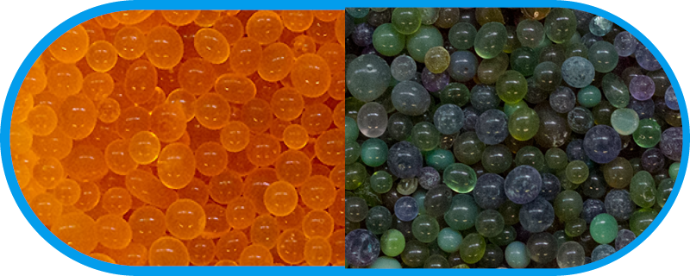PORESPHERE™ silica gels: Adsorb moisture & protect equipment from moisture damage.
High adsorption capacity up to 35% / 90%
With harmless color indicators
Usable at temperatures up to 100°C
Usable at humidity levels above 10% RH
Regenerable from 120°C
Buy online silica gels in Comparison Downloads Product comparison with BASF Sorbead®
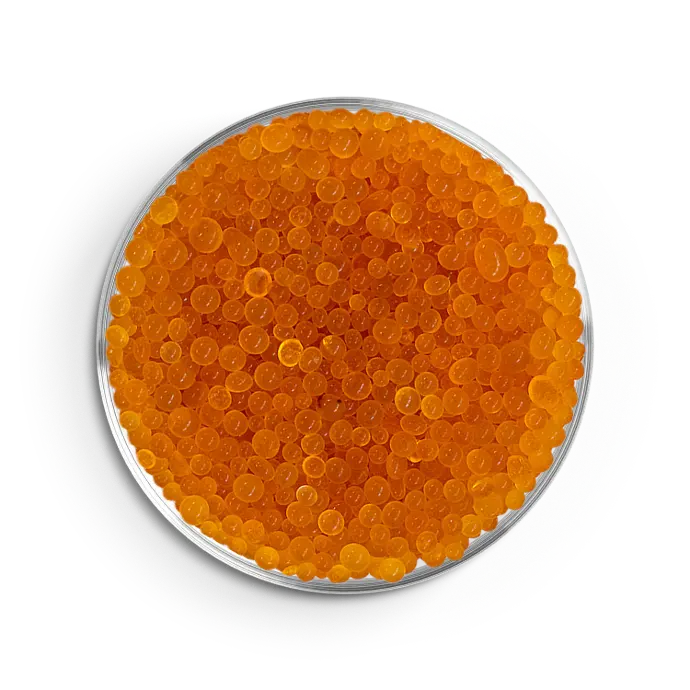
Standard Silicagele im Vergleich.

PORESPHERE™ A-Indicator OG
Mit unbedenklichem Farbindikator (Orange - Grün)
Color change at 10-20% loadF
High adsorption capacity (35%)
- Structure 99% SiO2 1% copper(II) chloride
- Grain size 3-5 mm
- Water absorption >370ml/kg
- Bulk density 0.78 g/ml
- Pore volume 0.35-0.45 ml/g
- Breaking strength >200N
- Specific surface area 600-800 sqm/g
- Abrasion rate <2%
- Regeneration at 120°C

PORESPHERE™ A-Indicator OC
With harmless color indicator (orange - colorless)
Color change at 20-25% load
High adsorption capacity (35%)
- Structure 99% SiO2 1% Ammonium iron(III) sulfate
- Grain size 3-5 mm
- Water absorption >370 ml/kg
- Bulk density 0.78 g/ml
- Pore volume 0,35-0,45ml/g
- Breaking strength >200N
- Specific surface area 600-800 sqm/g
- Abrasion rate <2%
- Regeneration at 120°C
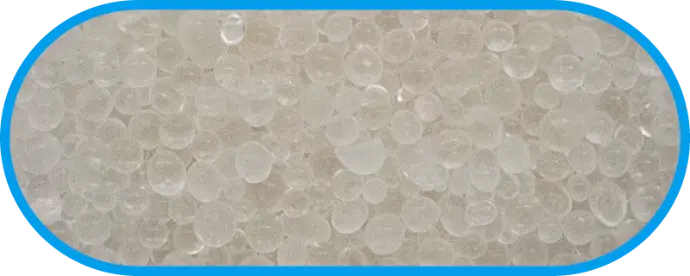
PORESPHERE® White
Without color indicator
High adsorption capacity (35%)
Constant drying
- Structure 99% SiO2
- Grain size 0.5–1.5 mm, 1–3 mm, 3–5 mm
- Water absorption >370 ml/kg
- Bulk density 0.77 g/ml
- Pore volume 0,35-0,45ml/g
- Breaking strength >200N
- Specific surface area 650-800 sqm/g
- Abrasion rate <2%
- Regeneration at 140°C

PORESPHERE™ Macro B
Without color indicator
Very high adsorption capacity (90%)
For fluctuating conditions
- Structure 99% SiO2
- Grain Size 2-5mm
- Water absorption >900 ml/kg
- Bulk density 0.5 g/ml
- Pore volume 0.85-1.00 ml/g
- Breaking strength >200N
- Specific surface area 650-800 sqm/g
- Abrasion rate <1%
- Regeneration at 140°C
Silicagel ALUMINA – für harte Fälle.
Silicagel mit Aluminiumoxid (Al2O3) versetzt für bessere Stabilität unter harten Bedingungen.
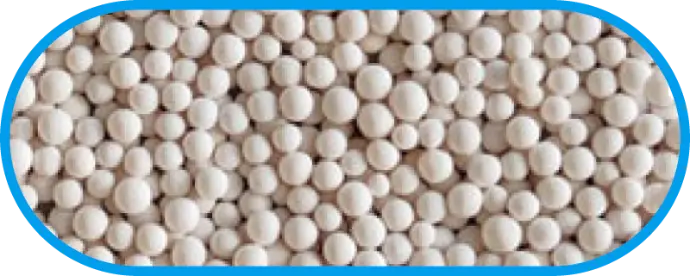
PORESPHERE™ AL-W (Water resistant)
Without color indicator
High adsorption capacity (35%)
Also adsorbs liquid water
- Structure 86.5% SiO2 13.5% Al2O3
- Grain size 3-5 mm
- Bulk density 0.749 g/ml
- Pore volume 0,42ml/g
- Breaking strength >97N
- Specific surface area 540 sqm/g
- Abrasion rate 0.03%
- Regeneration at 140°C
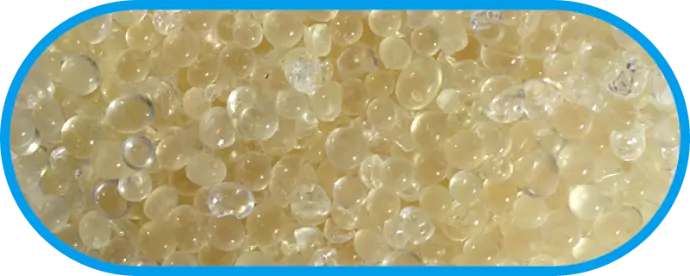
PORESPHERE™ AL-N
Without color indicator
High adsorption capacity (35%)
Constant adsorption
Robust structure
- Structure 97% SiO2 3% Al2O3
- Grain size 3-5 mm
- Bulk density 0.80 g/ml
- Pore volume 0,40ml/g
- Breaking strength >180N
- Specific surface area 750 sqm/g
- Regeneration at 140°C

PORESPHERE™ AL-H
Without color indicator
High adsorption capacity (35%)
Fast moisture absorption
Robust structure
- Structure 96.6% SiO2 3.4% Al2O3
- Grain size 3-5 mm
- Bulk density 0.725 g/ml
- Pore volume 0,49ml/g
- Breaking strength >211N
- Specific surface area 729 sqm/g
- Abrasion rate 0.01%
- Regeneration at 140°C
What makes PORESPHERE™ silica gel the ideal desiccant?
High water absorption
PORESPHERE™ silica gels can store up to 35% of their own weight in water. This is facilitated by their strong affinity to dipole molecules, a porous structure, and a large internal surface area.
Color indicator
PORESPHERE™ silica gels can be provided with a color indicator that changes color to indicate when maximum water absorption capacity has been reached.
Non-toxic & chemically inert
PORESPHERE™ silica gels are non-toxic, chemically inert, and resistant to almost all acids. This makes them suitable for use in the food industry and pharmaceuticals.
Regenerable
Water molecules are attached to the silicon dioxide by what are known as Van der Waals forces. This physical process is reversible. When PORESPHERE™ silica gels are heated to over 120°C, the water molecules are released again.
Wie unterscheiden sich unsere Standard PORESPHERE® Produkte?
PORESPHERE® Makro-B
6-12 nm pore diameter
For environments with high humidity
Quickly absorb large amounts of water from humid air
Not suitable for precise drying of residual moisture
PORESPHERE® Indikator + White
2-4 nm pore diameter
For environments with low humidity
Dehumidify already dry air even further
Available with color indicator (orange-green and orange-colorless)
What makes PORESPHERE™ Alumina dry beads special?
Our alumina dry beads combine the high adsorption capacity of classic silica gels with the additional stability of aluminum oxide. They are ideal for demanding drying processes that require temperature changes, high moisture loads, or chemical resistance. Their spherical structure and optimized pore size distribution ensure maximum efficiency and uniform air flow.
AL-N is the basic variant of the alumina series: stable, resilient, and with optimal adsorption properties. AL-H is used in high-performance applications that require temperature resistance with high adsorption capacity and can withstand thermal stress. AL-W is resistant to liquid water and retains its structure and adsorption properties when in direct contact with it.
AL-N (Standard)
Structurally stable, even under prolonged stress
Has an alkaline surface
Absorption of acidic components and polar molecules
AL-H (High Performance)
Temperature resistance combined with high adsorption capacity
Stable under thermal stress and strain
Flexible use in various conditions
AL-W (water resistant)
Resistant to liquid water
Good adsorption properties when exposed to moisture
Regenerierbar
Where is PORESPHERE silica gel used?
Packaging
In packaging, PORESPHERE™ silica gels protect sensitive products such as electronics, leather goods, textiles, and optical devices from moisture damage.
They prevent mold growth, corrosion, and odor formation during storage and shipping, thereby helping to avoid complaints.
Transformators
Silica gels are used in transformer dehumidifiers to dry the incoming air before it comes into contact with the insulating oil.
They keep the moisture content in the oil consistently low, protect against internal corrosion, and extend the service life of the equipment.
Industry
PORESPHERE™ silica gels are used in industrial applications to protect machines, components, or control systems in enclosed housings from humidity.
They prevent condensation from forming, protect electronics and mechanics, and reduce the risk of breakdowns and repairs.
Pharma
Silica gels are used in the pharmaceutical industry to keep sensitive preparations dry—for example, in blister packs, tubes, and diagnostic kits..
They prevent moisture from degrading active ingredients, ensure stable storage conditions, and contribute to consistent product quality.
Which color indicators are used in silica gels & how do they work?
PORESPHERE™ silica gels are available with color indicators. These indicate when the desiccant has reached its saturation point and needs to be replaced or regenerated by changing color.
At GIEBEL, we use two harmless color indicators: copper(II) sulfate (copper salt) and iron(III) chloride (iron salt). These are organic substances that change color depending on the pH value.
Copper(II) sulfate (copper salt) changes color from orange to green.
Ideal when a high-contrast color change is desired
Iron(III) chloride (iron salt) changes color from orange to white.
Ideal when a subtle color change is desired
We strongly advise against using silica gels containing the color indicator cobalt(II) chloride (heavy metal)! This is a proven carcinogenic SVHC substance.
Silica gel with indicator Orange - green Silicagel with indicator orange-colorless Conformation of cobald-free status (DE) CONFORMATION OF COBALD-FREE STATUS (EN)
Downloads.
FAQ about Silica gels.
Features
There are different types of silica gel which differ in their chemical composition, color, and intended use. Basically, silica gel is an amorphous, highly porous silicon dioxide (SiO₂) that is capable of adsorbing large amounts of moisture from the ambient air.
Silica gel is available in various forms: colorless (indicator-free), color-changing (with a moisture indicator), and specialized forms with varying pore structures or additional functionality. The choice of the right silica gel depends on the specific application: whether for moisture protection in packaging, for protecting electronics, or for industrial drying. Our company offers all common silica gel types, individually tailored to your needs.
The effectiveness of silica gel depends largely on the ambient conditions, humidity, temperature, and the amount of material used. In typical packaging or storage applications, high-quality silica gel can adsorb moisture for 4 to 12 weeks at normal humidity (40–60% RH) before reaching saturation. In dry environments, it can even remain active for many months.
Silica gel is often impregnated with color indicators to visualize the saturation level reached. The color change is usually from orange to dark green, providing high contrast and reliably indicating when the material has reached its capacity. Silica gel is also available with other color indicators, such as orange to white and blue to pink.
Silica gels without color indicators are also available. However, indicator-free silica gel must be replaced regularly or monitored using alternative methods.
Yes, saturated silica gel can be regenerated and reused multiple times through proper heating. Thermal regeneration reliably restores its adsorption capacity. High-quality silica gel can withstand numerous drying cycles and remains effective if properly treated. For product variants with a color indicator, the color returns after drying and once again indicates the saturation level.
The silica gel is spread out on a baking sheet and dried in a standard oven at 120°C (depending on the type of silica) for approximately five hours. Higher temperatures should be avoided to avoid damaging the material. It is recommended to repeat this process a maximum of five times before replacing the silica gel completely.
So-called self-regeneration is also possible. In this process, the already dried air flushes the water out of the material during the cyclic breathing of a container or system as exhaust air. This partially discharges the desiccant without external heat input or pressure changes, significantly extending its service life.
The maximum moisture absorption of silica gel is up to 37% of its own weight. This means that 1 kg of dry silica gel can adsorb up to 370 g of water vapor from the air under optimal conditions.
These values depend on the relative humidity, the ambient temperature, the pore structure and grain size of the desiccant, and the material quality. Silica gel works particularly efficiently at high humidity levels. This absorption capacity makes silica gel one of the most effective and versatile desiccants for industrial, technical, and residential humidity control applications.
To maintain its maximum adsorption capacity, silica gel must be stored in a dry, airtight container, and protected from environmental influences. Silica gel begins to absorb moisture immediately upon exposure to ambient air—even at relatively low humidity. Therefore, proper storage is crucial for long-term functionality. Sealed, moisture-proof containers or packaging are ideal. Opened containers should be used promptly or resealed airtight. If stored improperly, the material may become saturated with moisture before its intended use and should then be regenerated first.
The term "self-regeneration" of silica gel refers to the material's ability to restore part of its adsorption capacity independently under certain conditions—that is, without targeted technical regeneration such as heating in an oven. In practice, this form of "self-drying" is often observed when environmental conditions change significantly, especially during fluctuations in temperature or humidity.
Silica gel physically binds moisture in its porous structure (adsorption). Unlike chemical bonds, this adsorption is reversible—meaning the moisture can be released again. This occurs when humidity drops significantly, but also when ambient temperatures increase. This passive drying process is called self-regeneration, but it is only partially effective. It does not release the full amount of bound water, but can almost double the potential service life before the material becomes fully saturated.Silicagel bindet Feuchtigkeit physikalisch in seiner porösen Struktur (Adsorption). Anders als chemische Bindungen ist diese Adsorption reversibel – das heißt, die Feuchtigkeit kann auch wieder abgegeben werden. Dies geschieht bei stark sinkender Luftfeuchtigkeit aber auch bei Erwärmung durch Umgebungseinflüsse. Diese passive Rücktrocknung wird als Eigenregeneration bezeichnet, ist aber nur teilweise wirksam. Sie gibt nicht die volle gebundene Wassermenge ab, kann aber die mögliche Nutzungsdauer vor einer vollen Sättigung des Materials fast verdoppeln.
However, to restore the full moisture absorption capacity, targeted thermal regeneration in the furnace is required. This completely removes the adsorbed water from the pores of the silica gel, allowing it to function like new again.
Color indicators in silica gel are used to visually detect moisture content—that is, whether the silica gel is still active or already saturated and no longer capable of adsorption. These indicators are chemical additives that change color visibly depending on the moisture content, allowing for quick and easy monitoring—without the need for technical measuring devices.
Silica gel itself is colorless or white. To visualize the saturation state, small amounts of organic color indicators are added to the material. Due to their nature as weak acids or bases, these indicators react with water in chemical-physical reactions. As the water content in the material increases, the pH value increases, and the color changes, for example, from orange to green or white.
This process is reversible and can be repeated. Heating removes the moisture, and the color indicator returns to its original color due to the lack of water.
Fiel of Application
The choice between narrow-pore and wide-pore silica gel—also referred to as Type A and Type B/C—depends largely on the relative humidity, the desired adsorption performance, and the intended use. Both types differ in the size of their pore structure and thus in their ability to absorb water vapor at different humidity levels.
Narrow-pore silica gel (Type A) is particularly suitable for low humidity and precise humidity control, for example in electronics, medicine or laboratory applications.
Wide-pore silica gel (type B or C) is preferably used in high or changing humidity conditions, for example in packaging, logistics or in the presence of organic vapors.Weitporiges Silicagel (Typ B oder C) wird bevorzugt bei hoher oder wechselnder Luftfeuchte, etwa in Verpackungen, Logistik oder bei organischen Dämpfen eingesetzt.
The choice of pore size significantly influences the efficiency and service life of the desiccant – the appropriate silica gel should be selected specifically for the application. In complex applications, a mixture of both types may also be useful, e.g., for short-term adsorption (Type B) and ultra-fine drying (Type A).
Narrow-pore types are used, for example, to protect sensitive electronics, effectively absorbing even very low levels of residual moisture. Wide-pore types, on the other hand, are ideal for packaging with highly fluctuating humidity levels, as they remain functional despite these changes.
The key difference between silica gel with indicators and silica gel without indicators lies in the ability to visually monitor moisture levels. While both variants can adsorb moisture equally effectively, only silica gel with a color indicator allows for visible detection of the saturation level—which is crucial in many applications.
The ambient temperature has a direct influence on the effectiveness of silica gel in adsorbing moisture. Generally speaking, the higher the temperature, the lower the adsorption capacity – and vice versa. This effect can be explained physically and should always be taken into account when selecting and planning drying solutions. While silica gel is very effective at 20°C, its adsorption capacity can decrease significantly at 40°C or higher. Therefore, in hot environments, the amount used should be adjusted, the packaging optimized, or regeneration performed more frequently.
If the temperature of the incoming air rises beyond this limit, the use of molecular sieves or mixtures containing molecular sieves is recommended instead. These offer excellent water vapor absorption capacity even at temperatures well above 40°C. Their ventilation drying ability remains more consistent over a wider temperature range than silica gel.
The selection of the appropriate silica gel depends crucially on the ambient humidity level. Relative humidity (RH) is particularly relevant – that is, the proportion of water vapor in the air relative to the maximum possible humidity at a given temperature.
The pore size of the silica gel is crucial for its appropriate use. This determines how well water molecules can be bound at different humidity levels. The following generally applies:
Weite Poren (Typ B)(Poresphere Makro B) = besser bei viel Wasserdampf für effiziente Adsorption
Narrow pores (Type A) = better with little water vapor and as little residual moisture as possible
Yes, silica gel can be safely used in food packaging, provided it is specifically approved and certified for this purpose. In its pure, indicator-free form, silica gel is a chemically inert, non-toxic desiccant that does not react with food and is therefore food-safe—provided it meets certain regulatory requirements.
It must be:
- indicator-free (white/colorless), be approved under food law
- approved under food law, e.g. according to: EU Regulation (EC) No. 1935/2004 or FDA standard (21 CFR 182.2420) in the USA
- protected from direct contact in suitable packaging
Silica gel can be safely used in food packaging – provided it is indicator-free, certified food-safe, and correctly packaged. Pure, white silica gel without colorants is considered harmless to health and reliably protects food from moisture damage such as mold, spoilage, or loss of quality. Silica gel containing color indicators, on the other hand, is not food-safe and must not come into contact with food.
A ventilation dryer—also known as an air dryer or dehumidifier—is a technical unit that removes moisture from flowing air before it enters sensitive systems or components. This is crucial, for example, in compressed air systems, transformers, hydraulic systems, storage tanks, control cabinets, and even battery compartments.
Silica gel is so widely used in these applications because it is an extremely powerful, versatile, and regenerable desiccant that can efficiently adsorb water vapor, especially in air-conditioning systems – even at low temperatures and fluctuating humidity levels. It can adsorb large amounts of moisture from the air, protects sensitive systems from condensation and corrosion, and operates reliably even under constantly changing environmental conditions. This makes silica gel the preferred desiccant in industrial air-drying applications, transformers, compressed air systems, and other air-conditioning processes.
Safe Use
Yes, in its pure form, silica gel is safe and non-toxic to handle, both for humans and for most materials and products. It is a chemically inert, amorphous silicon dioxide (SiO₂) that does not emit toxic fumes, is non-reactive, and non-flammable. However, there are important differences between different silica gel variants that must be considered when assessing safety.
Many products contain color additives to visualize saturation. These indicators can contain hazardous substances, such as cobalt(II) chloride in blue. This substance is proven to be carcinogenic and toxic to fertility. Orange/green-based indicators are a safe alternative. However, these should not be swallowed or brought into contact with food.
According to European Union legislation, pure silica gel, molecular sieves, and aluminum oxide are not classified as hazardous. Therefore, if handled and used properly, no environmental problems are to be expected.
Silica gel is often colored with specific dyes that serve as indicators. Their color indicates when the material is saturated and can no longer absorb any more moisture. This provides guidance as to when the silica gel needs to be replaced or regenerated.
Blue silica gel contains hazardous cobalt(II) chloride and carries, among other things, the warning R49 - "may cause cancer by inhalation" - and is also teratogenic. Inhaling the dust, which contains heavy metals, should therefore be avoided at all costs. This dust can escape and enter the environment, especially when transferring the material or even when packaging bags are damaged slightly. On October 28, 2008, the ECHA (European Chemicals Agency) re-added the substance to the candidate list of substances of very high concern (SVHC). The entry was supplemented on June 20, 2011, to include reproductive toxicity.
Orange silica gel, on the other hand, uses other substances as a color indicator and is therefore considered harmless and non-toxic to humans and the environment, making it a safer alternative. White or colorless silica gel is equally safe and non-toxic to handle due to the lack of a color indicator.
Silica gel is subject to specific safety standards, norms, and legal requirements depending on the application and market, especially when used in areas such as food packaging, medicine, industry, or electronics protection. Compliance with these standards ensures that the desiccant is safe, high-quality, and suitable for its intended use.
Silica gel meets numerous international safety standards, including REACH, CLP, FDA, DIN 55473, and ISO standards, provided it is correctly manufactured and labeled. Only indicator-free, certified silica gel is permitted for use in food packaging, medical devices, or critical industrial areas. Users should always ensure compliance with applicable regulations and the submission of appropriate safety data sheets and certificates.
Die Poresphere Silicagele der GIEBEL Desiccants GmbH sind vollständig REACH zertifiziert.
In principle, yes – pure, indicator-free silica gel can be safely disposed of with household waste after use, as it is chemically inert, non-toxic, and environmentally neutral. However, there are important exceptions and recommendations, depending on the type of silica gel used and local disposal regulations.
If the silica gel is uncontaminated, it can also be regenerated by heating. This allows for multiple sustainable use cycles and can save on disposal costs. However, users should always observe local disposal regulations, especially for large quantities or commercial applications.
One exception is blue silica gel colored with cobalt(II) chloride. This is clearly classified as a hazardous substance and must be disposed of as special waste according to national legislation. Our portfolio consists exclusively of cobalt(II) chloride-free products.
Yes, Giebel Desiccants GmbH holds a valid REACH certification and therefore meets all necessary requirements for the import and trade of silica gel CAS 7631-86-9.
The REACH Regulation (Registration, Evaluation, Authorisation and Restriction of Chemicals) has been in force in the European Union since June 1, 2007. This comprehensive EU chemicals regulation regulates the manufacture, import, and use of chemical substances – such as silicon dioxide (SiO₂) CAS 7631-86-9. If more than one ton of silicon dioxide is imported into the EU per year, special requirements must be observed:
- We ensure that our silica gel products are registered according to REACH and can be used safely:
- We provide complete, REACH & CLP compliant safety data sheets (SDS).
- We support downstream users (e.g. processing companies) in secure use.
- We ensure transparency in the supply chain and fulfill our information obligations.
Packaging Units
Our silica gels are available in various packaging sizes. These are generally:
- 250g, 500g
- 1kg, 4kg, 20kg, 25kg, 150kg
We care about you & your products!
REQUEST A CALL BACKMore than 16,000 companies rely on our GIEBEL desiccants
Every year, our customers protect their machines and products with over 80,000 kg of silica gel and molecular sieves, preventing 26,400 liters of water from coming into contact with sensitive materials.
